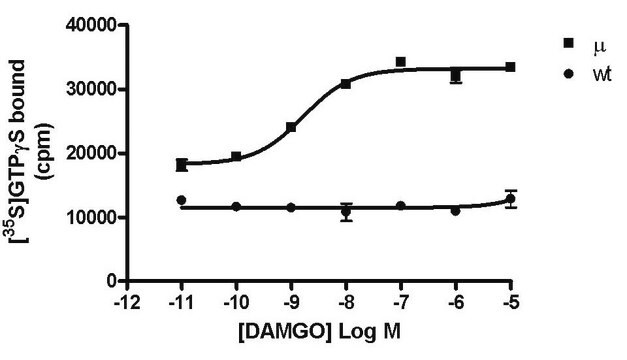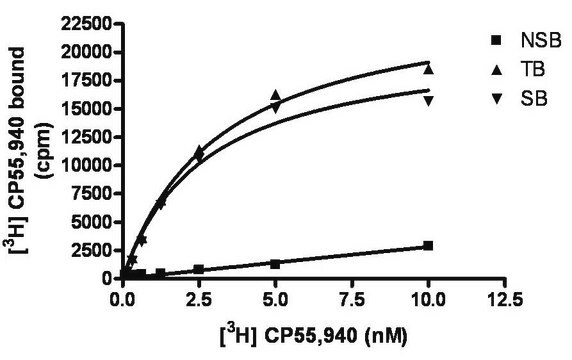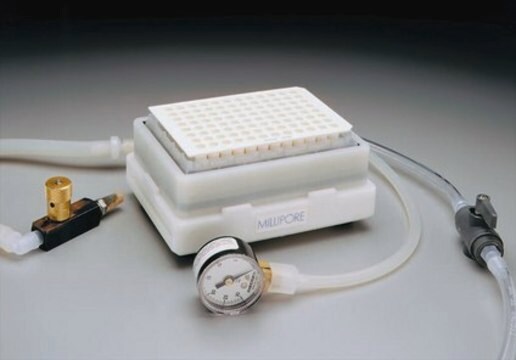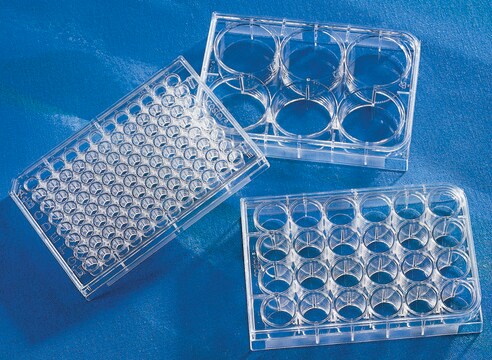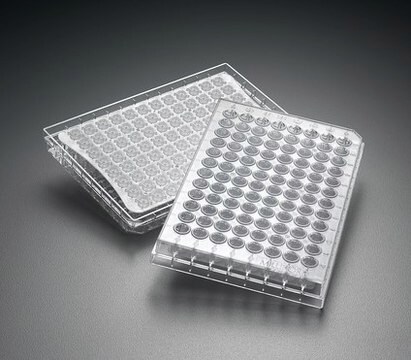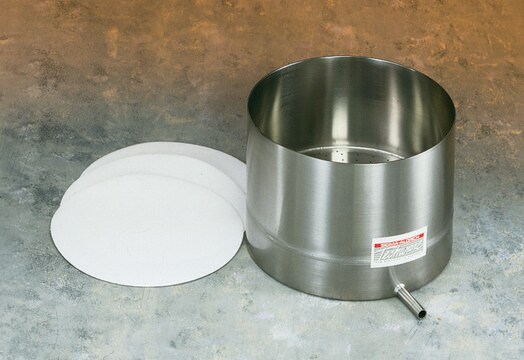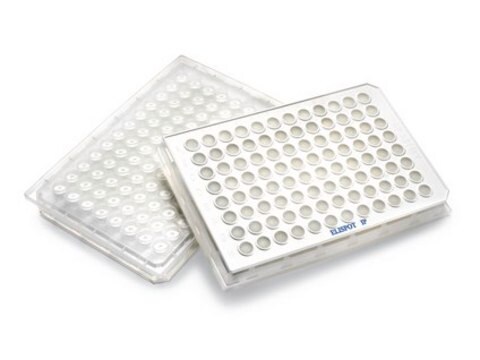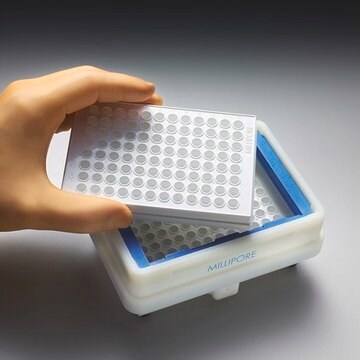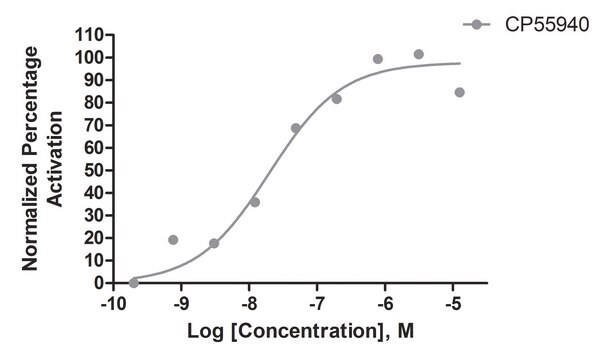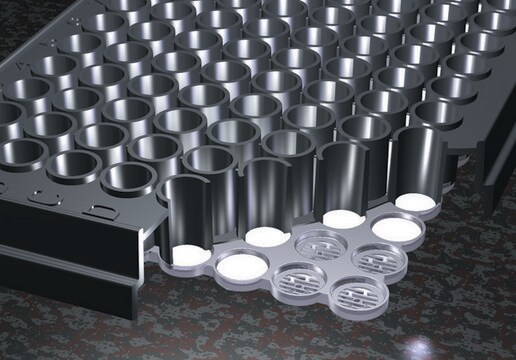HTS019M
ChemiSCREEN CB1 Membrane Preparation
Human CB1 GPCR membrane preparation for Radioligand binding Assays & GTPγS binding.
Synonyme(s) :
CB1 GPCR-expressing membrane prep
Se connecterpour consulter vos tarifs contractuels et ceux de votre entreprise/organisme
About This Item
Code UNSPSC :
41106514
eCl@ss :
32161000
Nomenclature NACRES :
NA.41
Produits recommandés
Source biologique
human
Niveau de qualité
Produit recombinant
expressed in Chem-1 cells
Fabricant/nom de marque
ChemiScreen
Chemicon®
Concentration
1.0 mg/mL
Technique(s)
ligand binding assay: suitable (GTPγS)
radioligand binding assay (RLBA): suitable
Numéro d'accès NCBI
Numéro d'accès UniProt
Conditions d'expédition
dry ice
Description générale
CB1 is a GPCR that is expressed primarily in brain and nervous tissue, and mediates numerous CNS responses such as analgesia, appetite, cognition, memory and locomotor activity. A number of cannabinoid ligands bind to CB1 and activate Gi/o-mediated downstream responses, including inhibition of cAMP production and activation of ion channels and MAP kinases. Ligands for CB1 include exogenous agonists such as Delta9-THC, the main psychoactive component of the plant Cannabis sativa, and endogenous eicosanoid agonists such as anandamide. A number of synthetic agonists such as CP55940 and R-(+)-WIN55212, and antagonists, such as SR141716A, for CB1 have been developed (Howlett et al., 2002). CB1 agonists have clinical utility in analgesia and antiemetic properties, whereas CB1 antagonists show promise for treatment of appetite in obesity disorders. Chemicon′s CB1 membrane preparations are crude membrane preparations made from our proprietary stable recombinant cell lines to ensure high-level of GPCR surface expression; thus, they are ideal HTS tools for screening for agonists and antagonists at CB1. The membrane preparations exhibit a Kd of 7 nM for [3H]-SR141716A. In the presence of 2 nM [3H]-SR141716A with CP55940 as unlabeled competitor, 5 μg/well and 10 μg/well CB1 Membrane Prep yield 4- and 5-fold signal-to-background ratios, respectively.
Human CB1
Application
Human CB1 GPCR membrane preparation for Radioligand binding Assays & GTPγS binding.
Radioligand binding assay, and GTPγS binding.
Actions biochimiques/physiologiques
GPCR Class: A
Protein Target: CB1
Target Sub-Family: Cannabinoid
Qualité
SPECIFICATIONS:
1 unit = 10 μg
Bmax: 15 pmol/mg
Kd: 7 nM for SR141716A
1 unit = 10 μg
Bmax: 15 pmol/mg
Kd: 7 nM for SR141716A
Caractéristiques
Inucbation Conditions
RECOMMENDED ASSAY CONDITIONS: Membranes are mixed with radioactive ligand and unlabeled competitor (see Figures 1 and 2 for concentrations tested) in binding buffer in a nonbinding 96-well plate, and incubated for 1-2 h. Prior to filtration, a GF/C 96-well filter plate is coated with 0.33% polyethyleneimine for 30 min, then washed with 50mM HEPES, pH 7.4, 0.5% BSA. Binding reaction is transferred to the filter plate, and washed 3 times (1 mL per well per wash) with Wash Buffer. The plate is dried and counted.
Binding buffer: 50 mM Hepes, pH 7.4, 5 mM MgCl2, 1 mM CaCl2, 0.2% BSA, filtered and stored at 4°C. Ligands were diluted in binding buffer containing 30% DMSO, then added to membranes such that the final DMSO concentration was 15%.Radioligand: [3H] SR141716A (Amersham #TRK1028)
Wash Buffer: 50 mM Hepes, pH 7.4, 500mM NaCl , 0.1% BSA, filtered and stored at 4°C.
One vial contains enough membranes for at least 200 assays (units), where an unit is the amount of membrane that will yield approximately 4-fold signal:background with [3H] SR141716A at 2 nM
RECOMMENDED ASSAY CONDITIONS: Membranes are mixed with radioactive ligand and unlabeled competitor (see Figures 1 and 2 for concentrations tested) in binding buffer in a nonbinding 96-well plate, and incubated for 1-2 h. Prior to filtration, a GF/C 96-well filter plate is coated with 0.33% polyethyleneimine for 30 min, then washed with 50mM HEPES, pH 7.4, 0.5% BSA. Binding reaction is transferred to the filter plate, and washed 3 times (1 mL per well per wash) with Wash Buffer. The plate is dried and counted.
Binding buffer: 50 mM Hepes, pH 7.4, 5 mM MgCl2, 1 mM CaCl2, 0.2% BSA, filtered and stored at 4°C. Ligands were diluted in binding buffer containing 30% DMSO, then added to membranes such that the final DMSO concentration was 15%.Radioligand: [3H] SR141716A (Amersham #TRK1028)
Wash Buffer: 50 mM Hepes, pH 7.4, 500mM NaCl , 0.1% BSA, filtered and stored at 4°C.
One vial contains enough membranes for at least 200 assays (units), where an unit is the amount of membrane that will yield approximately 4-fold signal:background with [3H] SR141716A at 2 nM
Forme physique
Liquid in packaging buffer: 50 mM Tris pH 7.4, 10% glycerol and 1% BSA no preservatives.Packaging method: Membranes protein were adjusted to 0.5 mg/ml in 1 ml packaging buffer, rapidly frozen, and stored at -80°C.
Stockage et stabilité
Maintain frozen at -70°C for up to 2 years. Do not freeze and thaw.
Informations légales
CHEMICON is a registered trademark of Merck KGaA, Darmstadt, Germany
Clause de non-responsabilité
Ce produit, destiné à la recherche scientifique, est soumis à une réglementation spécifique en France, y compris pour les activités d′importation et d′exportation (Article L 1211-1 alinéa 2 du Code de la Santé Publique). L′acheteur (c′est-à-dire l′utilisateur FINAL) est tenu d′obtenir une autorisation d′importation auprès du ministère français de la recherche, mentionné à l′article L1245-5-1 II du Code de la Santé Publique. En commandant ce produit, vous confirmez détenir l′autorisation d′importation requise.
Code de la classe de stockage
10 - Combustible liquids
Classe de danger pour l'eau (WGK)
WGK 2
Certificats d'analyse (COA)
Recherchez un Certificats d'analyse (COA) en saisissant le numéro de lot du produit. Les numéros de lot figurent sur l'étiquette du produit après les mots "Lot" ou "Batch".
Déjà en possession de ce produit ?
Retrouvez la documentation relative aux produits que vous avez récemment achetés dans la Bibliothèque de documents.
Notre équipe de scientifiques dispose d'une expérience dans tous les secteurs de la recherche, notamment en sciences de la vie, science des matériaux, synthèse chimique, chromatographie, analyse et dans de nombreux autres domaines..
Contacter notre Service technique